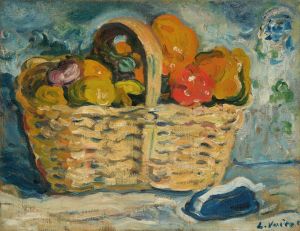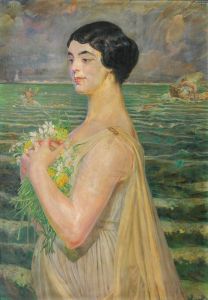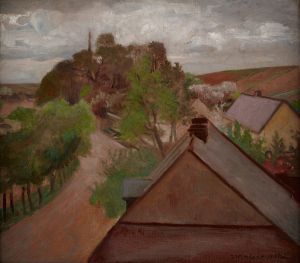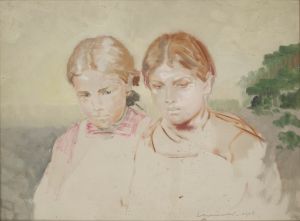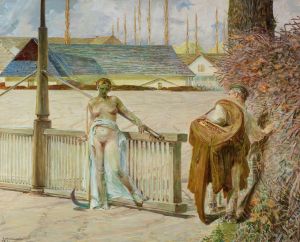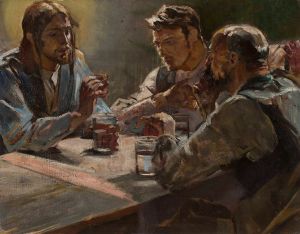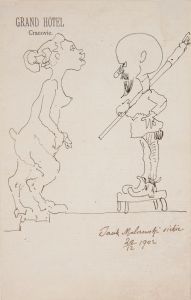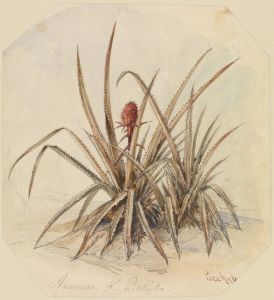
Portrait of a woman with rowanberry
A hand-painted replica of Jacek Malczewski’s masterpiece Portrait of a woman with rowanberry, meticulously crafted by professional artists to capture the true essence of the original. Each piece is created with museum-quality canvas and rare mineral pigments, carefully painted by experienced artists with delicate brushstrokes and rich, layered colors to perfectly recreate the texture of the original artwork. Unlike machine-printed reproductions, this hand-painted version brings the painting to life, infused with the artist’s emotions and skill in every stroke. Whether for personal collection or home decoration, it instantly elevates the artistic atmosphere of any space.
Jacek Malczewski, a prominent figure in Polish Symbolism, is renowned for his evocative and often allegorical works that delve into themes of national identity, mythology, and existential inquiry. One of his notable paintings, "Portrait of a Woman with Rowanberry," exemplifies his unique style and thematic interests. Although specific details about this particular painting are limited, it can be contextualized within Malczewski's broader oeuvre and the Symbolist movement.
Malczewski was born in 1854 in Radom, Poland, and his artistic career spanned the late 19th and early 20th centuries, a period marked by significant political and cultural upheaval in Poland. He studied at the School of Fine Arts in Kraków and later in Paris, where he was influenced by both Polish Romanticism and the broader European Symbolist movement. Symbolism, as an art movement, sought to express the ineffable, exploring themes of mysticism, dreams, and the human psyche through symbolic imagery.
"Portrait of a Woman with Rowanberry" likely reflects Malczewski's characteristic use of symbolism and allegory. Rowanberries, in various cultural contexts, are often associated with protection, transformation, and the mystical. In Slavic folklore, the rowan tree is considered sacred and protective, which might suggest that the painting imbues the depicted woman with these attributes or connects her to these themes. Malczewski frequently incorporated elements of Polish folklore and mythology into his works, using them as a means to explore and assert Polish cultural identity during a time when the nation was partitioned and lacked political sovereignty.
The portrayal of women in Malczewski's art often carries deep symbolic meaning. Women are frequently depicted as muses, allegorical figures, or embodiments of Poland itself. This aligns with the Symbolist tendency to use the female form as a vessel for broader existential and national themes. In "Portrait of a Woman with Rowanberry," the woman might serve as a symbol of resilience, continuity, or the spiritual essence of Poland, though without specific documentation, these interpretations remain within the realm of informed speculation based on Malczewski's known thematic preoccupations.
Malczewski's technique combines realistic portraiture with fantastical elements, creating a dreamlike quality that invites viewers to look beyond the surface. His use of color, light, and composition often enhances the symbolic content of his works, drawing the viewer into a contemplative space. While the exact visual details of "Portrait of a Woman with Rowanberry" are not extensively documented, it can be assumed that Malczewski employed his typical style, characterized by meticulous attention to detail and a harmonious blend of realism and symbolism.
Throughout his career, Malczewski remained deeply committed to exploring the Polish national spirit and identity through his art. His works are celebrated for their ability to convey complex themes with emotional depth and intellectual rigor. "Portrait of a Woman with Rowanberry," like many of his paintings, serves as a testament to his skill as an artist and his dedication to capturing the essence of Polish culture and identity.
In summary, while specific information about "Portrait of a Woman with Rowanberry" is scarce, understanding Jacek Malczewski's broader artistic context and thematic concerns allows for an appreciation of the painting's potential significance within his body of work.







